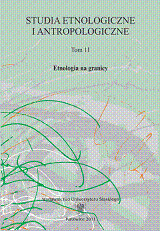Współdziałanie społeczne podczas obrzędu weselnego w Polsce — rodzaje pomocy i kierunki zmian
Social cooperation during the wedding ceremony in Poland — types of help and directions of changes
Author(s): Anna DróżdżSubject(s): Anthropology
Published by: Wydawnictwo Uniwersytetu Śląskiego
Summary/Abstract: The article raises the issue of social cooperation during the wedding ceremony in Poland in the second half of the 19th century. In the majority of works devoted to the wedding we come across the analysis in which the authors pay attention to above all the dramatic, ludic, etc. function of the very phenomenon. The participation of the members of the village community in this ceremony was perceived in a very similar way. In the foreground were the ritual, dramatic and folklore role and function. The wedding ceremony is though a series of actions in which participate both individuals and whole groups hidden behind the curtains of the action going on. O a large extent these are the actions thanks to which it is possible to organize the whole ceremony. In this context one should look into social cooperation. The exploration of the hidden and secondary functions of the engagement of the community members in the wedding enriches our knowledge on this ceremony. Help given by wedding participants took place during each stage. The easiest division of this problem to be suggested is a division from the point of view of a practical or, in the second case, a symbolic nature of the actions undertaken. The wedding ceremony in its concrete manifestations such as mutual help during its subsequent stages has not been a static form, transmitted from one generation to another in an unchanging form. A comparison of the 19th century and 20th century materials allowed for distinguishing changes cooperation underwent. The very processes went in two directions. Both in the case of phenomena in which the symbolic role was dominant and the ones which were characterized by a practical importance of the actions taken we encounter changes and loss. The analysis of violence manifestations given at the wedding time shows the observer the whole scale of aspects and meanings of the role of the group at the time of the wedding. This hidden importance of the participation of the community, often densely veiled with gestures and more spectacular behaviours largely constitutes the basic principle of the ceremony. The interpretation of cooperation and changes happening in its area enable the examination of the functions of the wedding ceremony in a wider context of social life.
Journal: Studia Etnologiczne i Antropologiczne
- Issue Year: 2011
- Issue No: 11
- Page Range: 220-230
- Page Count: 11
- Language: Polish

